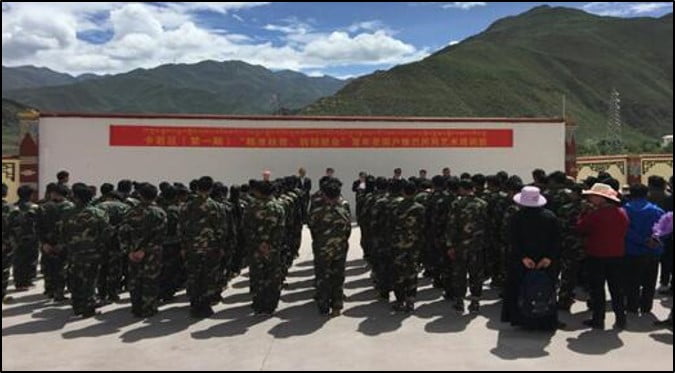In 2019 and 2020, the Tibet Autonomous Region (TAR) introduced new policies to promote the systematic, centralized, and large-scale training and transfer of “rural surplus laborers” to other parts of the TAR, as well as to other provinces of the People’s Republic of China (PRC). In the first 7 months of 2020, the region had trained over half a million rural surplus laborers through this policy. This scheme encompasses Tibetans of all ages, covers the entire region, and is distinct from the coercive vocational training of secondary students and young adults reported by exile Tibetans (RFA, October 29, 2019).
The labor transfer policy mandates that pastoralists and farmers are to be subjected to centralized “military-style” (军旅式, junlüshi) vocational training, which aims to reform “backward thinking” and includes training in “work discipline,” law, and the Chinese language. Examples from the TAR’s Chamdo region indicate that the militarized training regimen is supervised by People’s Armed Police drill sergeants, and training photos published by state media show Tibetan trainees dressed in military fatigues (see accompanying images).
Poverty alleviation reports bluntly say that the state must “stop raising up lazy people.” Documents state that the “strict military-style management” of the vocational training process “strengthens [the Tibetans’] weak work discipline” and reforms their “backward thinking.” Tibetans are to be transformed from “[being] unwilling to move” to becoming willing to participate, a process that requires “diluting the negative influence of religion.” This is aided by a worrisome new scheme that “encourages” Tibetans to hand over their land and herds to government-run cooperatives, turning them into wage laborers.
An order-oriented, batch-style matching and training mechanism trains laborers based on company needs. Training, matching and delivery of workers to their work destination takes place in a centralized fashion. Recruitments rely, among other things, on village-based work teams, an intrusive social control mechanism pioneered in the TAR by Chen Quanguo (陈全国), and later used in Xinjiang to identify Uyghurs who should be sent to internment camps (China Brief, September 21, 2017). Key policy documents state that cadres who fail to achieve the mandated quotas are subject to “strict rewards and punishments” (严格奖惩措施, yange jiangcheng cuoshi). The goal of the scheme is to achieve Xi Jinping’s signature goal of eradicating absolute poverty by increasing rural disposable incomes. This means that Tibetan nomads and farmers must change their livelihoods so that they earn a measurable cash income, and can therefore be declared “poverty-free.”
This draconian scheme shows a disturbing number of close similarities to the system of coercive vocational training and labor transfer established in Xinjiang. The fact that Tibet and Xinjiang share many of the same social control and securitization mechanisms—in each case introduced under administrations directed by Chen Quanguo—renders the adaptation of one region’s scheme to the other particularly straightforward.
Historical Context
As early as 2005, the TAR had a small-scale rural surplus labor training and employment initiative for pastoralists and farmers in Lhasa (Sina, May 13, 2005). The 11th Five-Year Plan (2006-2010) then specified that this type of training and labor transfer was to be conducted throughout the TAR (PRC Government, February 8, 2006). From 2012, the Chamdo region initiated a “military-style training for surplus labor force transfer for pastoral and agricultural regions” (农牧区富余劳动力转移就业军旅式培训, nongmuqu fuyu laodongli zhuanyi jiuye junlüshi peixun) (Tibet’s Chamdo, October 8, 2014). Chamdo’s scheme was formally established in the region’s 13th Five-Year Plan (2016-2020), with the goal of training 65,000 laborers (including urban unemployed persons) during that time (Chamdo Government, December 29, 2015).
By 2016, Chamdo had established 45 related vocational training bases (TAR Government, November 17, 2016). Starting in 2016, the TAR’s Shannan region likewise implemented vocational training with “semi-military-style management” (半军事化管理, ban junshihua guanli) (Tibet Shannan Net, April 5, 2017). Several different sources indicate that Chamdo’s military-style training management was conducted by People’s Armed Police drill sergeants.[1]



